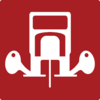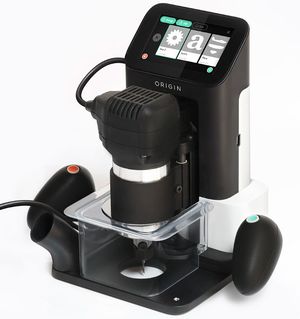Difference between revisions of "Handheld CNC Router"
| Line 65: | Line 65: | ||
==Safety== | ==Safety== | ||
| − | + | * | |
==Certification== | ==Certification== | ||
| Line 72: | Line 72: | ||
==Troubleshooting== | ==Troubleshooting== | ||
| + | * | ||
==Maintenance== | ==Maintenance== | ||
Revision as of 15:44, 19 June 2019
Make: Shaper
Model: S01-NN Origin
Ace: Needed (Makerhub@georgefox.edu).
Location: Wood Shop
Description
The handheld CNC is a relatively small and portable computer automated router that can be moved around a flat, wooden surface. It uses location tracking and a moving spindle to provide an easy way to make precise cuts using a handheld machine which makes it great for performing high precision or detailed cuts. A camera is used to track its location by referencing a special tape which you apply to the surface you want to cut on. The spindle and router bit for the CNC are small, so the CNC is best suited for shallow cuts and engraving work. Despite the shallow cuts, the CNC is still capable of cutting non-shallow material thicknesses, it just means that multiple passes will have to be made.
Documentation
Terminology
- SVG - SVG is the file type for the graphics file that the CNC uses for its cuts. SVG stands for “Scalable Vector Graphics” and can be opened/modified with Adobe Illustrator, GIMP, and some others.
- Pocket Cut - The cut setting for hallowing out the center of a shape.
- Shaper Tape - A custom tape with special graphics on it that is used by the router to orient itself in space.
User Manual
Training
Overview
Before a cut can be performed with the handheld CNC router you must provide a cut design in the form of an SVG file. These can be created in several different programs but Inkscape is recommended because it is installed on the hub computers and is free to download onto a personal device. When designing your cut use the actual dimensions of the cut. If it is your first time using Inkscape there are tutorials on their website and Youtube as well. After you have created the cut file transfer it to the router using a USB drive or by uploading it over WiFi. Take the CNC out of the box, set it on a flat, wooden surface, and plug it in. Ensure that the dust collection vacuum is working and has a good seal on the CNC connecting piece. You should never use the CNC without dust collection working! Determine the area on the wood material that you want to cut on and place several strips of tape a bit beyond the width and height of the area you’ll need, with 4-6 inch separation between the tape strips (they don’t need to be straight and parallel, they can be crooked). The CNC uses this tape to manage the CNC’s position. Double check that the correct router bit is secure and in place in the spindle. If the router bit needs to be replaced or secured, make sure that the spindle is turned off and unplugged from the main computer of the router before you take the spindle out of its place. Keep in mind that the switch for the spindle only turns off the spindle, not the CNC computer system. On the touch interface, select the scan mode and create a new scan for the tape. Move the CNC around the surface until all of the (unripped) tape is highlighted blue. It is important to have enough tape, if the CNC loses track of enough tape it will immediately raise the spindle and stop the router from cutting any material. Once you’re ready, go to the cut menu on the CNC’s touch interface and select the correct diameter for your router bit and the depth your want to cut at. It will ask you to “touch off”, select yes. Touching off means that the CNC will lower the router until it just touches the surface in order to calibrate the depth control for the router. Select the appropriate cut type (inside, outside, on-line, or pocket) for the cut you will be making. The pocket cut type will cut out the entire area of the shape you have selected. The guide cut type will not act as a cutting line, it will only show on the display as a reference. You can preview the cut size and direction by looking at the direction of the dashed outline and the thicker, grey line on top of the small, dashed line. Double check that the spindle speed (the control wheel to the right of the spindle) is set correctly. Before you make your first cut, double check the tape accuracy by moving the CNC around and watching the tape icon on the top-right of the display. This shows how much tape is visible to the camera, so the more full the tape bar is the better. If it is consistently low, it may be best to add more tape and do a new scan. Once these things have been completed, you should be good to go for cutting! Keep in mind that you may have to do multiple passes to get the right depth and you may also have to change cut type depending on what kind of cut you’re trying to make.
Demonstration
For the demonstration, download this file as an SVG and open it in Inkscape. Download the SVG template from Shaper's website and copy that into the previously downloaded image. Use the eyedropper tool and paint can tool to replace the black outline of the bear with the grey color found on the template. Add a black box around the bear to act as an edge to cut through. Make sure that there is enough distance from the box to the bear, as the black line indicates an inside cut (so the router bit will be cutting on the inside of the box). Once finished, delete the template and save the file as an SVG to an SD card. Complete the demonstration by setting up the router and cutting the file.
General Procedure
Once this has been done, unscrew the bolt on the right of the spindle just loose enough to remove the spindle. To remove the router bit, press down on the locking mechanism and twist the collet until the router bit can be removed. Make sure that the router bit grooves are not below a quarter inch from the top of the collet. Once a new router bit has been put in place, use the wrench to tighten the collet. Reinsert the spindle into the slot on the CNC and tighten the bolt “finger tight”. At this point, the CNC is set up and ready to go, it is time to scan the tape.
Creating Cut Files:
Setting up the Cut Area:
Performing a Cut:
Safety
Certification
Troubleshooting
Maintenance
General maintenance
Insert text
Specific Maintenance Tasks
| Maintenance Procedure | Frequency | Done By |
|---|---|---|
| Sample | Sample | Sample |

